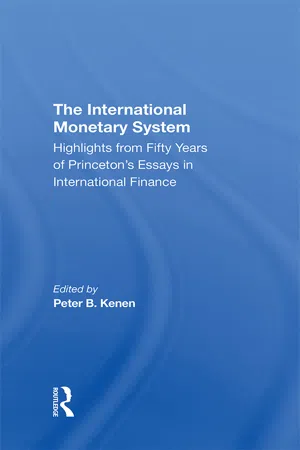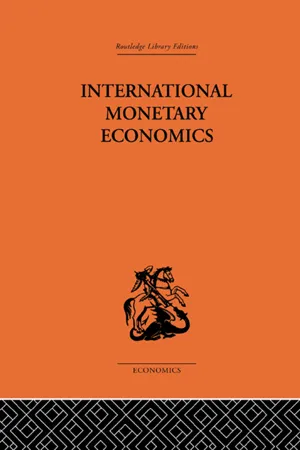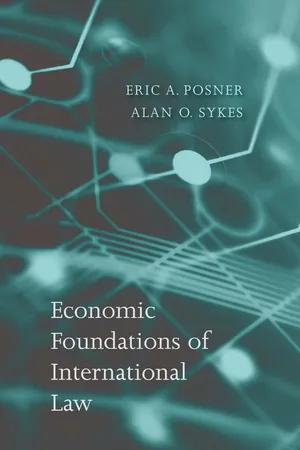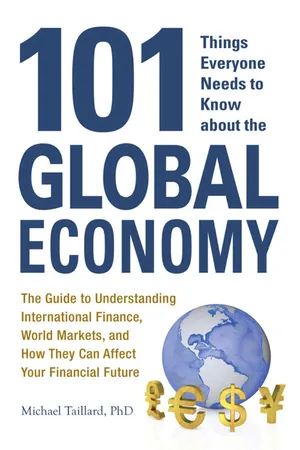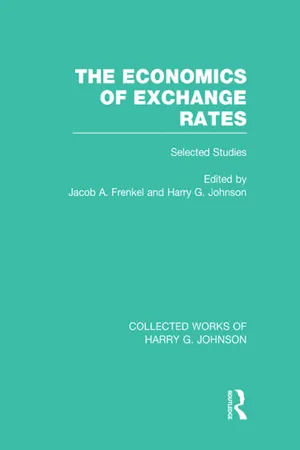Economics
Devaluation and Revaluation
Devaluation refers to a deliberate decrease in the value of a country's currency relative to other currencies, often to boost exports and economic growth. Revaluation, on the other hand, involves a deliberate increase in the value of a country's currency. Both devaluation and revaluation can have significant impacts on a country's trade balance, inflation, and overall economic competitiveness.
Written by Perlego with AI-assistance
Related key terms
1 of 5
6 Key excerpts on "Devaluation and Revaluation"
- eBook - PDF
The International Monetary System
Highlights From Fifty Years Of Princeton's Essays In International Finance
- Peter B Kenen(Author)
- 2019(Publication Date)
- Taylor & Francis(Publisher)
7 Currency Devaluation in Developing Countries Richard N Cooper Currency devaluation is one of the most dramatic-even traumatic-measures of economic policy. that a government may undertake. It al-most always generates cries of outrage and calls for the responsible offi-cials to resign. For these reasons alone, governments are reluctant to devalue their currencies. Yet under the present rules of the international monetary system, laid down in the Articles of Agreement of the Inter-national Monetary Fund, devaluation is encouraged whenever a coun-try's international payments position is in tcfundamental disequilibrium,'' whether that disequilibrium is brought about by factors outside the country or by indigenous developments. Because of the associated trauma, which arises because so many economic adjustments to a discrete change in the exchange rate are crowded into a relatively short period, currency devaluation has come to be regarded as a measure of last resort, with countless partial substitutes adopted before devaluation is finally undertaken. Despite this procrastination, over 200 devaluations in fact occurred between the inauguration of the IMF in 1947 and the end of 1970; to be sure, some were small and many took place in the years of postwar readjustment, especially 1949. In addition, there were five upvaluations, or revaluations, of currencies. Two more· occurred in May 1971. By convention, changes in the value of a currency are measured against the American dollar, so a devaluation means a reduction in the dollar price of a unit of foreign currency or, what is the same thing, an in-crease in the number of units of the foreign currency that can be pur-chased for a dollar. - eBook - PDF
Who Adjusts?
Domestic Sources of Foreign Economic Policy during the Interwar Years
- Beth A. Simmons(Author)
- 2020(Publication Date)
- Princeton University Press(Publisher)
When surplus countries did so (as the United States did in 1933), it only made it all the more difficult for those who remained on gold. Yet, currency depreciation was a live option whenever countries suffered 1 Cmd. 1667, 1922, Part II, Report of the Second Commission (Finance), and Cmd. 1650, Resolutions Adopted by the Financial Commission of the 20th and 29th of April 1922, Resolu-tions 4, 5, 8 and 11(6). 2 By contrast, post-World War II economic theory emphasizes not only the role of currency devaluation in restoring the balance between trading partners, but also the domestic expenditure switching effects of devaluation that channel resources into the traded-goods sector. Postwar conceptions view depreciation or devaluation as modes of economic adjustment with both internal and external distributive consequences. Devaluations are often advocated by the international financial community as part of a broader adjustment package both to improve the balance of trade and to channel investment toward the export sector. During the interwar years, only the French devaluation of 1936 approached international consensus on the need to devalue. I know of no other major case in which a negotiated devaluation took place. DEVALUATION 107 severe balance of payments deficits, and it was often difficult to avoid in the face of surging capital outflows. To avoid depreciation would require a credible commitment to stabilize domestic prices via monetary stringency and a bal-anced government budget. The credibility of such a commitment was sensitive to domestic political conditions, as evidenced by the negative effects of politi-cal instability, labor unrest, politically controlled central banks, and left-wing participation in governance on capital flows and/or the current account. - eBook - ePub
- Fritz Machlup(Author)
- 2013(Publication Date)
- Routledge(Publisher)
Even under these conditions it is difficult to prove conclusively that resource allocation will actually be “improved.” The case against direct controls and for the working of the price mechanism is not convincing to everybody, and even many who on principle advocate allocation through the operation of free and competitive markets admit that there may be exceptional situations in which direct controls may operate in a more painless way. The second possibility (b), that devaluation may reduce or remove distortions in relative costs and prices, is always present, but the opposite is also possible. At first blush one may be impressed by the fact that devaluation will act like the removal of export taxes and of import subsidies—and by the presumption that taxes and subsidies distort relative prices. But devaluation may with equal justification be likened to the introduction of export subsidies and import taxes—and the presumption then would be that distortions are created rather than removed. Thus one has to establish in each particular situation that the resource allocation before devaluation is not an optimal one—owing to certain defects or restrictions in the operation of the markets—and can be improved through an adjustment of the exchange rate. (This is the possibility illustrated in our analogy.)The third of the possible reallocation benefits, the conservation of foreign-exchange reserves, presupposes of course that devaluation has its “normal” effect of improving the trade balance. But even so, one may object to a conceptual framework under which a substitution between different assets (foreign reserve versus home investment) or a substitution between assets and consumer goods (foreign reserves versus consumption) is interpreted as a gain or loss in income. This objection will surely be sustained when the substitution in question is attributable to deliberate decisions to use foreign assets or incur foreign debts to obtain imports; the objection will perhaps be dismissed in situations where the authorities expressly “deplore” the loss of reserves as unintended and unfortunate if not calamitous.The difference between these situations, which is pointed up by the distinction between autonomous and accommodating capital imports, can be elucidated by simple examples. Assume an initial situation in which no capital movements take place. Now an autonomous inflow of capital sets in, resulting either in an appreciation of the currency or in an expansion of money incomes and, in either case, in an increase in prices of domestic goods and services relative to prices of foreign-trade goods. There will be some substitution by domestic industry of foreign for domestic materials and of imported machines for domestic labor; moreover, some resources previously used for export production will be transferred to home use. This resource reallocation will be associated with a decrease in foreign assets or increase in foreign debts—which, of course, is the “realization” of the autonomous capital inflow. When the capital inflow stops, the opposite movements will take place. - eBook - ePub
- Eric Posner, Alan O. Sykes, Eric A. Posner, A. O Sykes(Authors)
- 2013(Publication Date)
- Belknap Press(Publisher)
Chapter 18 , the ratio of import prices to export prices is the nation’s terms of trade. An unexpected devaluation thus worsens the terms of trade for the nation that devalues under our local currency pricing assumption and concomitantly improves the terms of trade for trading partners—a positive externality from their perspective. Of course, an upward revaluation of the currency would have the opposite result.The general point is that from the perspective of trading partners, exchange rate movements create both positive and negative terms of trade externalities. There is no simple result suggesting that exchange rate movements are necessarily harmful. Indeed, the practice that brought forth the greatest number of complaints historically—devaluation—may actually confer a positive terms of trade externality in many cases for the reason just noted. It is thus hardly obvious that fixed exchange rate systems have any advantage over allowing rates to be determined in the market if one focuses on the externality that flows through the terms of trade.Another set of externalities relates to macroeconomic policies. These too can be complicated, and so we simply provide a flavor of the issues. Imagine a fixed exchange rate system, and let one major country pursue an inflationary monetary policy. The result will be downward pressure on the value of its currency, while other currencies tend to appreciate. To prevent appreciation and maintain the fixed rate, other nations must intervene by selling their currencies and buying the currency of the inflating country. Such intervention increases the money supply of the other currencies and thus precipitates inflation elsewhere. Thus, inflationary policy can be “exported” under a fixed rate system to nations that do not wish to have inflation.Conversely, imagine that a major country pursues a contractionary monetary policy. Other countries must now buy their currencies to avoid depreciation and maintain the fixed rate. This policy reduces their money supply, raises interest rates, and may tend to cause contraction in their economies. In this sense, contractionary policies initiated in one country may lead to undesired economic contraction in others. Recall the research noted earlier arguing that precisely this phenomenon may have contributed to a worsening of the Great Depression. - eBook - ePub
101 Things Everyone Needs to Know about the Global Economy
The Guide to Understanding International Finance, World Markets, and How They Can Affect Your Financial Future
- Michael Taillard(Author)
- 2012(Publication Date)
- Adams Media(Publisher)
Let’s say the U.S. dollar and Mexican peso are exchanged at a one-to-one ratio (USD1 = MXN1) because the Mexican peso is pegged to the U.S. dollar. The Mexican government wants to decrease the exchange rate of its currency; they issue a statement that one dollar now equals, for example, 0.75 pesos. Such a change is called devaluation —the Mexican government, which has a fixed currency, has lowered its exchange rate. The U.S. dollar now buys fewer pesos. The opposite move, wherein a fixed currency increases its exchange rate, is called revaluation. Using the same basic example as before (which was chosen for its simplicity rather than any sort of accuracy regarding the exchange rate or currency policy of the nations discussed), should the Mexican government decide that they want to revalue the peg on their currency by 25 percent, from USD1 = MXN1, then the new exchange rate would be set to USD1 = MXN1.25, using Mexican federal economic policy as the mechanism for the change. What You Should Know The ability to manage the rate at which a fixed currency is exchanged is critical to maintaining economic stability. Nations will periodically alter their exchange rate in order to account for any changes to their economic growth - eBook - ePub
- Jacob Frenkel, Harry Johnson, Jacob A. Frenkel, Harry G. Johnson(Authors)
- 2013(Publication Date)
- Routledge(Publisher)
11The second effect of devaluation is a transient change in both the production and consumption pattern caused by the relative price change. The rise in the relative price of traded goods induces an increase in their production and a decrease in the quantity demanded domestically, while the supply of nontraded goods falls and their demand rises. The devaluation-induced relative price change will, however, tend to be reversed over time. The mechanism by which this takes place is that the initial change in relative prices generates an excess demand for nontraded goods, and this pushes up their price. If the full equilibrium position of the economy is unique, we would expect the devaluation to have no permanent effect on relative prices. This follows from the property of the model of homogeneity of degree zero in all nominal variables. Hence, in the long run, devaluation has no real effects.12 The reason why there are real short-run effects of devaluation, or, in other words, the reason why relative price changes at all, is that initially spending differs from income.These two effects of devaluation might be termed an expenditure-reducing effect and an expenditure-switching effect (cf. Johnson, 1958). IV. SIMULATION RESULTSIn this section, the estimated model is used to simulate a hypothetical devaluation of the U.S. dollar. The effects of this shock on U.S. trade and prices are isolated by comparing the new solution to the model with the control solution. The former is obtained by solving the model each period using the previous period’s simulated values of the endogenous variables for this period’s lagged endogenous variables, the new values of the exogenous variables associated with the hypothetical policy change, and the actual values of the remaining exogenous variables. The control solution is obtained by solving the model dynamically with the actual values of all
Index pages curate the most relevant extracts from our library of academic textbooks. They’ve been created using an in-house natural language model (NLM), each adding context and meaning to key research topics.
